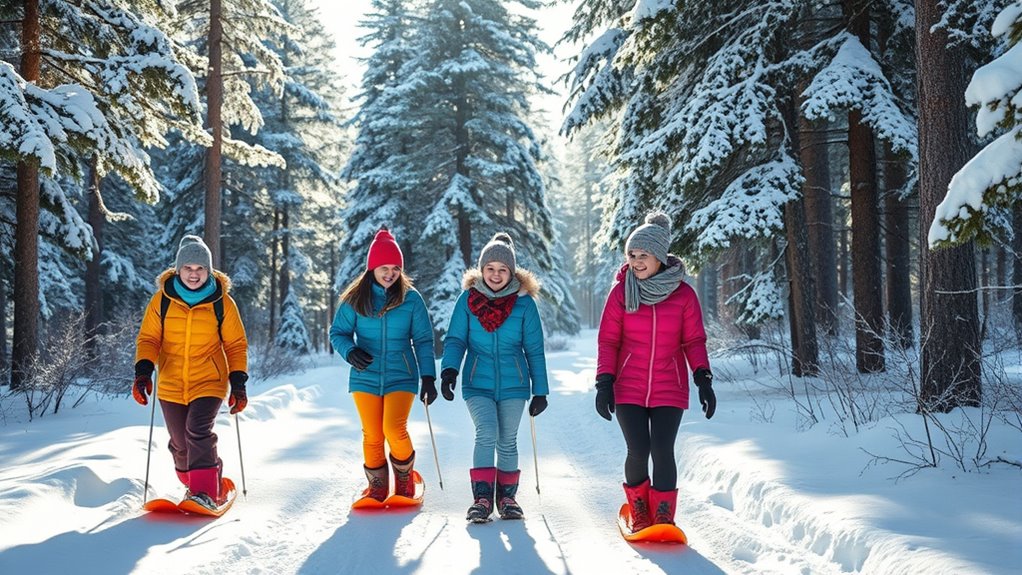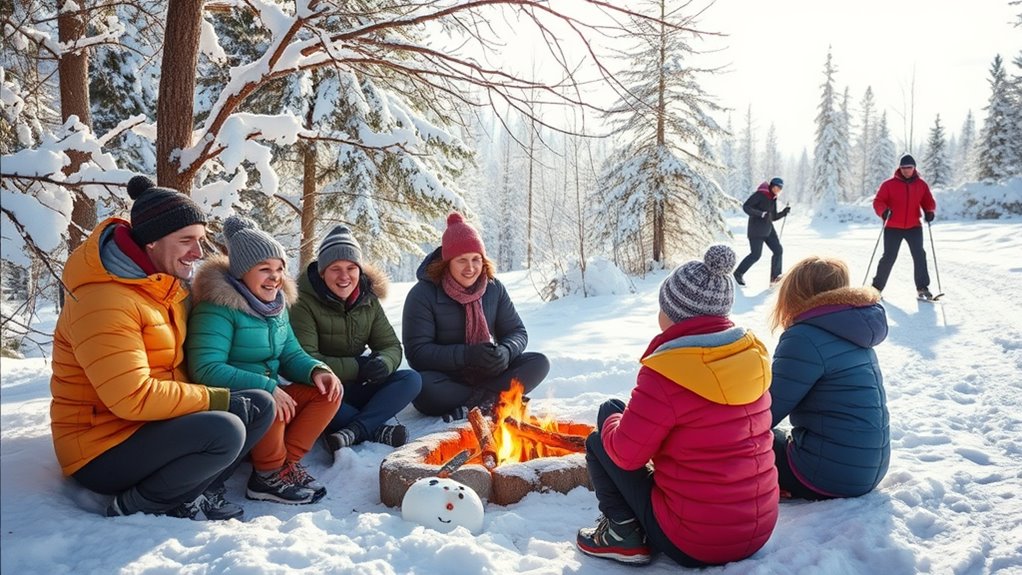On cold weather days, you can enjoy outdoor activities like winter hiking and snowshoeing to stay active and take in the serene snow-covered landscapes. Dressing in layered, waterproof gear and using sturdy boots with good traction will keep you safe. Snowshoeing offers a fun, vigorous workout, while winter hikes give you peaceful, scenic solitude. If you want to discover more tips to make these adventures enjoyable and safe, there’s plenty more to explore.
Key Takeaways
- Engage in winter hiking or snowshoeing to explore scenic, snow-covered landscapes safely with proper gear.
- Dress in layered, moisture-wicking clothing and use waterproof boots for comfort and safety outdoors.
- Take advantage of the crisp winter air for physical activity that boosts health and mental well-being.
- Start activities early in the day to maximize daylight and ensure safety on trails and open fields.
- Consider guided tours or equipment rentals to learn new winter activities and enhance your outdoor experience.

When the temperature drops and snow begins to fall, it might seem like outdoor fun is off the table. But if you’re willing to bundle up and embrace the chill, you’ll find plenty of exciting activities that make the most of cold weather. One of the best ways to enjoy winter’s beauty is through winter hiking. Instead of avoiding trails, you can lace up your boots and explore snow-covered landscapes. Many trails transform into winter wonderlands, offering peaceful solitude and stunning scenery. Just make sure you wear layered clothing, waterproof gear, and sturdy boots with good traction. Carrying trekking poles can help maintain balance on icy patches, and starting early in the day gives you plenty of daylight to enjoy your hike safely.
If you want to extend your outdoor adventures, snowshoeing is an excellent option. It’s easy to pick up and doesn’t require much equipment—just rent or buy a pair of snowshoes, and you’re ready to go. Snowshoeing allows you to traverse deep snow that would be impossible to walk through otherwise. It’s a fantastic workout, engaging your core, legs, and arms, all while letting you glide smoothly over snow-covered terrain. Plus, it offers a unique perspective of the winter landscape, with every step creating a quiet crunch beneath your feet. Snowshoeing can be done on marked trails or through open fields, making it versatile for different skill levels and environments.
Both winter hiking and snowshoeing are fantastic ways to stay active, breathe in the crisp winter air, and witness nature’s quiet beauty. You’ll find that these activities not only boost your physical health but also clear your mind and lift your spirits during the darker, colder months. Remember to dress in moisture-wicking layers, wear a warm hat and gloves, and bring plenty of water and snacks. If you’re new to snowshoeing, consider joining a guided tour or renting equipment from a local outdoor shop to learn the basics. Additionally, using appropriate gear such as good traction boots and moisture-wicking layers can significantly improve your experience and safety. With proper preparation, these activities can become your favorite winter rituals, keeping you energized and connected with the outdoors when most people stay inside. Embracing winter hiking and snowshoeing transforms cold days into opportunities for adventure, discovery, and enjoying the pristine beauty that only winter can offer.
Frequently Asked Questions
What Safety Gear Is Essential for Cold Outdoor Activities?
You should always wear thermal gloves and a reflective vest for cold outdoor activities. Thermal gloves keep your hands warm and prevent frostbite, while a reflective vest guarantees you’re visible to others, especially in low light conditions. Consider layering with moisture-wicking clothing, a warm hat, and sturdy boots. These safety gear essentials help you stay warm, protected, and visible, making your outdoor experience safer and more enjoyable.
How Can I Prevent Frostbite During Outdoor Winter Sports?
To prevent frostbite during outdoor winter sports, you should dress in layers, keeping your extremities well-covered with insulated gloves, hats, and thermal socks. Stay dry and take frequent breaks to warm up, which helps with hypothermia prevention. Be aware of frostbite symptoms like numbness, white or grayish skin, and tingling. If you notice these signs, get inside immediately, and seek medical attention to avoid lasting damage.
What Are the Best Clothing Layers for Freezing Temperatures?
Think of your clothing as a fortress against the cold. Start with thermal insulation layers that trap heat, like brick walls defending a castle. Add moisture management layers that wick sweat away, preventing chills and dampness inside. Finish with a waterproof outer shell to block wind and snow. This layered approach keeps you warm, dry, and ready to face freezing temperatures head-on.
How Do I Choose Appropriate Footwear for Snowy Terrain?
You should choose waterproof, insulated boots with proper insoles for warmth and comfort. Look for footwear with good traction devices like crampons or slip-resistant soles to prevent slipping on snow and ice. Make certain your boots fit well to avoid blisters, and consider gaiters for added protection against snow. Prioritize support and durability, so you stay steady and warm during your snowy adventures.
What Are Some Indoor Alternatives When Outdoor Weather Is Too Severe?
Think of your day as a cozy fire waiting to be ignited. When the weather’s too harsh, you can warm up indoors with fitness routines that get your blood pumping or plunge into craft projects that spark creativity. These indoor activities keep you active and engaged, turning chilly, severe days into perfect opportunities to relax and enjoy your space. Embrace the comfort and make the best of indoor fun.
Conclusion
Don’t let the cold weather keep you indoors; instead, embrace it like a crisp, invigorating breeze that awakens your spirit. Bundle up, stay active, and enjoy the winter wonderland outside. Whether you’re sledding down hills or taking a brisk walk, these activities turn chilly days into adventures waiting to happen. Remember, the cold can be your canvas—paint your outdoor day with fun and energy, making every frosty moment a memory to cherish.









